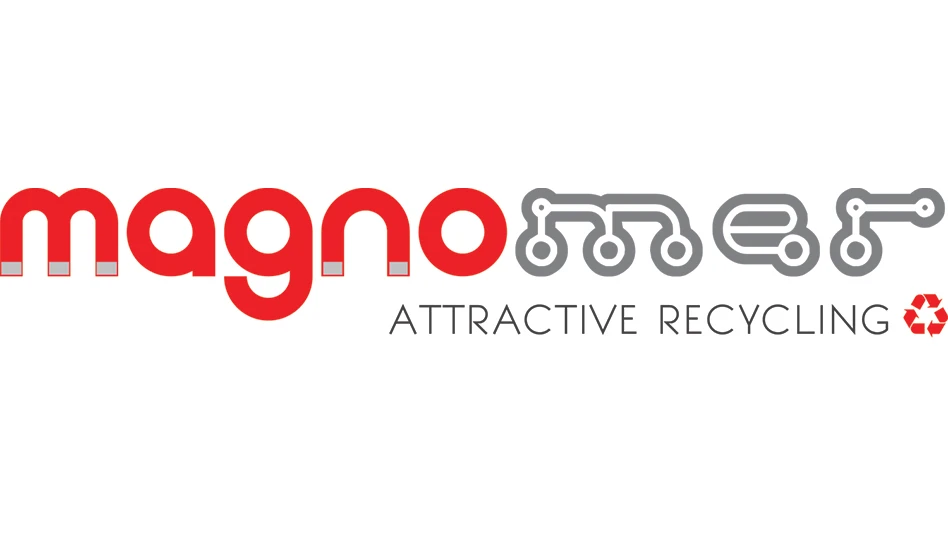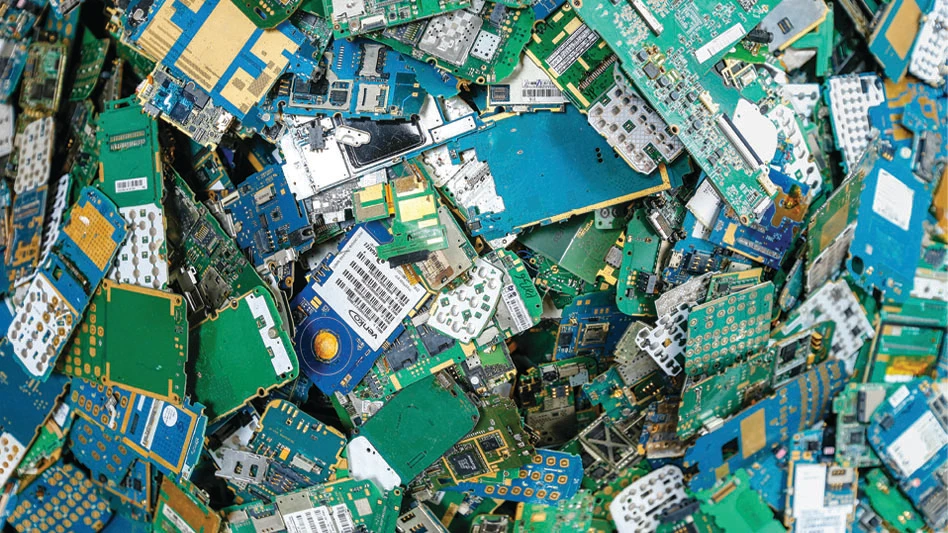
The bales of siding and aluminum sheet sit row after row, stacked four high and surrounding buildings and even the three-hole golf course at the Shanghai Sigma Metals Inc. manufacturing complex in China’s largest city.
Sigma Metals President Tony Huang points out, however, that this impressive volume of scrap does not represent a speculative position in the market. It is simply enough scrap to make sure the company’s multiple furnaces can be stocked for the next 30 to 45 days.
The Sigma story reflects the global nature of the metals industry while also demonstrating the tremendous capacity growth occurring in the People’s Republic of China as that nation concentrates on boosting its economy into a 21st century powerhouse.
ACROSS BORDERS. The Shanghai Sigma Metals complex accurately depicts the tremendous growth in China’s manufacturing economy, but the story behind the company is one that involves several nations.
Sigma President Tony Huang is from Taiwan and entered the scrap business while living in the United States after graduating from Cornell University in Ithaca, N.Y. with a degree in food sciences.
| At a Glance: The Sigma Group |
|
PRINCIPAL: Tony Huang, president of Shanghai Sigma Metals Inc.
LOCATIONS: Shanghai Sigma Metals Inc. in Shanghai and Shenzhen, China; Sigma Brothers Inc., Kaohsiung, Taiwan; Global Metal Industrial Corp., East Brunswick, N.J.; Sigma International Inc., St. Petersburg, Fla.; Sigma Holdings Inc., British Virgin Islands NUMBER OF EMPLOYEES: Approximately 2,200, with the majority PRODUCTION EQUIPMENT: 16 reverberatory and 10 rotary furnaces for secondary aluminum; three furnaces for zinc alloys; dross processing systems SCRAP GRADES PURCHASED: Tabor, taint, zorba, telic, UBCs. |
While attending Cornell and upon graduating, Huang began working with relatives back in Taiwan to help them set up offices to trade in both seafood and scrap metal, and established Sigma International Inc. in New Jersey as a trading office for these oddly matched commodities.
The metals business in Taiwan during those years was particularly robust, and Huang and his family grew that side of the business by establishing Sigma Brothers Inc. as a scrap trading office in Taiwan in 1981.
Then, five years later the company began building a 60,000-metric-tons-per-year secondary aluminum smelting plant in Kaohsiung, Taiwan.
The 1980s also coincided with the opening up of the economy of the People’s Republic of China, as Premiere Deng Xiaoping began wholesale changes in the way China conducted business both within the country and with the rest of the world.
While links between Taiwan and the U.S. scrap market helped forge Sigma’s initial success, the next step was the founding of Shanghai Sigma Metals Inc. in 1993 and the acquisition of a plant that would grow to 120,000 metric tons of annual secondary aluminum smelting capacity (as well as 12,000 metric tons of zinc alloy, produced as a byproduct).
The Shanghai facility used labor-intensive sorting of imported scrap on the front end combined with high-tech furnaces and testing procedures to produce aluminum alloy ingots that have proven acceptable to Japanese automakers and other major Sigma customers.
This multi-national model takes advantage of the economic conditions of several different nations: the availability of abundant obsolete aluminum scrap in the United States; using affordable labor in China; and serving the needs of aluminum alloy customers in the productive Japanese auto and appliance markets.
The formula has proven successful to the point that Sigma has outgrown its original Shanghai facility and in early 2005 moved into its newly constructed manufacturing complex that has annual capacities of 300,000 metric tons for aluminum alloy and 45,000 metric tons for zinc.
SIGMA TODAY. The sprawling Shanghai complex, located on 89 acres of land, is the largest and most productive of all of Sigma’s holdings, but there is more to the company than this one facility.
In addition to the Shanghai plant, Sigma continues to produce ingots in Kaohsiung, Taiwan, and as of 2004 began procuring scrap through Global Metal Industrial Corp., a purchasing agent office located in East Brunswick, N.J. Global Metal also has traders located in California.
The company has also established an overall holding company based in the British Virgin Islands as well as a physical warehouse and sales office in the fast-growing southern China city of Shenzhen.
This last location could be the key to one of Sigma’s next strategic moves. Although there is still room to add melting capacity in Shanghai, Huang remarks that a potential future move is "possibly a plant in south China, to serve its growing auto industry."
The auto industry is clearly an important one to Sigma, which is currently sending two-thirds of its finished product to Japan, mostly to serve that nation’s transportation segment. The company’s facilities are ISO 9001 and ISO 14001 audited, and every melt is checked for its chemistry content to meet the stringent standards of Toyota, Honda and other Asian automakers.
The company produces alloys that are registered with the London Metals Exchange (LME) and has been among the first Chinese companies to seek membership in both ISRI (the Institute of Scrap Recycling Industries Inc.) and the Bureau of International Recycling (BIR).
| Working on a Grand Scale |
|
Employing 1,000 people to sort scrap is neither now nor has ever been a common practice in North America. For Shanghai Sigma Metals Inc., it is possible because of the availability of abundant labor in Shanghai, a city of as many as 16 million people, many of whom are recent arrivals from the countryside seeking employment. Employing so many people presents challenges and creates a work atmosphere that looks unusual to visiting Americans. Among the challenges is defending against the theft of scrap, as the value of the material has become well known to people in China. The Shanghai Sigma complex features a canal system that surrounds the complex, effectively creating a moat that makes it very difficult for dishonest employees or thieves to toss scrap over a fence for later re-sale. At the same time, Shanghai Sigma Metals President Tony Huang has also taken measures to introduce positive incentives such as cash bonuses for sorting teams that perform the best. |
Sigma has been ramping up capacity in Shanghai each year, producing some 137,000 tons of alloy product in 2005, with some 240,000 tons likely to be produced this year. Last year, about 67 percent of what was produced was exported (with Japan being the leading destination), and this year that figure is likely to remain above 60 percent.
But Huang notes that more of Sigma’s ingots are staying in China to serve the nation’s growing automotive sector. "Only about 70,000 metric tons stayed in China in 2005, but we’ll ship as much as 90,000 metric tons domestically this year," says Huang.
The pattern reflects an overall growth pattern that Huang says has been a pleasant surprise throughout Sigma’s history. "We were not expecting to grow so fast," he remarks. "When I came to China 13 years ago, we ran and old plant producing 3,000 metric tons per month; then 6,000 tons; then 9,000 tons. We soon saw there was a need to build a bigger plant—and we really should have done it before that."

No matter where the ingot is going, almost all of the scrap is coming in from overseas, with North America being the dominant contributor. Huang estimates that fully 63 percent of Sigma’s aluminum scrap comes from North America, with Europe contributing 14 percent and South America, Australia and other Asian nations providing the other 23 percent. "We’re the largest importer of aluminum scrap in Asia," says Huang, estimating that the 138,000 metric tons the company purchased in 2005 represents 10 percent of what was imported.
About 54 percent of what comes in is old casts and baled aluminum sheet (the ISRI grades tense and taint/tabor), followed by 38 percent zorba (nonferrous auto shred), with the remainder being other grades that Sigma’s buyers can round up, including used beverage containers (UBCs) and borings and turnings (the ISRI telic grade).
Of Shanghai Sigma’s 2,000 employees, as many as 1,000 of them are involved in a sprawling sorting operation that allows the company to use the zorba grade.
This predominantly female segment of the workforce works in teams, with incentives provided for those achieving the highest production and quality levels.
The massive sorting operation is critical to allowing Sigma to purchase a variety of grades and not be dependent on one or two types of scrap. "We are not limited to a narrow number of grades," says Huang. "This is a necessity; our [melting] recipe changes depending on the prices of grades."
The labor-intensive sorting operation is probably the most unfamiliar element to a North American visitor, as Shanghai Sigma’s reverberatory and rotary furnaces, its casting lines and its executive offices are on par or exceed what one would expect to see in North America.
The massive labor force is affordable for now though, says Huang. "Ninety percent of our cost is in the [scrap] material," he says. "Wage rates here provide us the opportunity to buy lower-grade and contaminated materials and still make high-grade alloys."
CHINA’S MARKET. North American scrap dealers must certainly wonder for how long Sigma will need to rely on imports from across the Pacific Ocean for feedstock.
Huang says it will be a "long, long time" before China is in a scrap balance situation. While nations like the United States produce a steady stream of zorba, Huang notes that China has only five or six auto shredders, and that even these are under-utilized since China’s automotive population is relatively new. Even older cars tend to be sent into the interior of the country where new cars are not typically as affordable, he adds.
There are other reasons why Huang avoids the domestic scrap market, including what he refers to as schemes and corruption involving the nation’s value-added tax (VAT) as it is applied to scrap.
Since the scrap trade is largely cash-based, Huang says many dealers avoid the VAT altogether, eventually rendering the domestic scrap trade in China "nearly 100 percent illegal," according to Huang.
He has made the decision that rather than risking Sigma’s reputation and profits on an eventual crack-down of this tax evasion scheme, he would prefer to make legitimate purchases of overseas scrap until the time comes when scrap can be purchased honestly within China.
Huang says that should the dishonesty be wrung from the system, then Sigma may very well set up scrap collection operations domestically within China and enter the recycling industry aggressively.
He is hopeful that such a day is approaching and sees a change in heart from the Chinese government to some extent toward recycling and secondary resources.
"Just two years ago, the government and the public largely looked at us as criminals [who were] bringing in garbage," says Huang.
However, some changes in perception have been happening in Beijing that Huang hopes will spread throughout the People’s Republic of China. "Now the energy savings [of using secondary materials] is clear," he remarks. "China, right now, is heavily promoting the recycling industry."
Sigma Metals in particular was recently recognized as a model company in China’s Circular Economy initiative, according to Huang. The Circular Economy initiative, which combines economic and environmental sustainability aspects, has reportedly been supported by the national legislature, the World Bank and even Chinese President Hu Jintao.
A late May statement from China’s EPA touts saving energy in manufacturing processes as a key.
It is a step in the direction that Huang has been striving toward for more than 25 years as he builds Sigma’s market share, its brand and its reputation.
He has two sons who he hopes will follow his footsteps into Sigma’s secondary metals business, and he says retaining them within the company is one of his goals.
"I want to build a business I know they can be proud of—a place they can be proud to work and to make this their careers," Huang states.
The author is editor of Recycling Today and can be reached at btaylor@gie.net.

Explore the July 2006 Issue
Check out more from this issue and find your next story to read.
Latest from Recycling Today
- Haber raises $44M to expand to North America
- Canada Plastics Pact releases 2023-24 Impact Report
- Reconomy brands receive platinum ratings from EcoVadis
- Sortera Technologies ‘owning and operating’ aluminum sorting solutions
- IDTechEx sees electric-powered construction equipment growth
- Global steel output recedes in November
- Fitch Ratings sees reasons for steel optimism in 2025
- P+PB adds new board members





